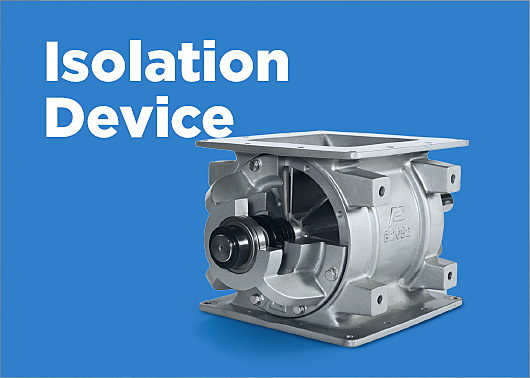
If an explosion happens in your machinery, there are ways to stop the spread of the flames before they get out of control.
One of the ways to do this is by using an isolation device—such as a rotary airlock valve.
Just to be clear—an isolation device won’t prevent and protect against deflagration in your system. Prevention means eliminating any ignition sources in your machinery and your plant that could lead to deflagration.
Deflagration is a form of combustion that is caused by a heat source igniting cold materials to create a fast moving fire. This can cause a fast moving fire that leads to a chain reaction as materials continue to combust, making this type of explosion difficult to control.
Passive isolation devices, such as rotary valves, stop the spread of flames by preventing them from continuing on through the machinery, or reducing extra oxygen from fueling the flames.
NFPA 69: Standard on Explosions Prevention Systems goes into detail on isolation devices and how to prevent, control and contain explosions in systems that process combustible material.
Here’s a quick breakdown on some of the things you should be looking for to make sure your rotary valves are NFPA 69 compliant.
What to look for in rotary valve design
There are two ways you can limit oxygen as an ignition source in your machinery:
Material Blocking: At least one foot (30 centimetres) of material should remain in the hopper. This also allows for wider clearances in your housing.
Close-Clearance: Clearances under 0.0079 inches (2 millimetres) should be part of the valve’s manufacturing. These need to be closely maintained and inspected to ensure clearance doesn’t increase over time, and to keep flames from passing through the valves.
NFPA 69 recommends that you keep a record of inspections for at least a year, or for the last three inspections.
Inside the valve: rotors and vanes
You should have a minimum of eight vanes and there should be at least two vanes in contact with each side of the valve housing at all times to make sure that flames are contained within the rotor pockets, should an explosion happen. Your vanes should be at least three millimetres thick with metal tips. Rubber or plastic tips won’t hold up against the heat or pressure of a deflagration.
Outside the valve: outboard bearings
Not only do you want to ensure proper isolation of flames, but you also want to prevent your rotary valve from becoming an ignition source in itself.
One way to do this is to install a temperature switch on your outboard bearings to stop the valves when excessive heat is detected. Excessive heat can be prevented by operating your rotary valves at a low speed. This means that tip speed shouldn’t exceed one metre per second or 200 rpm (rotations per minute).
Your shaft-seal assembly should eliminate heat and reduce static electricity. We recommend a sleeve-style shaft seal made of Teflon®, which reduces the friction force between the packing and the valve rotor shaft.
You can also install a metal detector upstream of the rotary valve to catch tramp metal and eliminate resulting friction.
Each material requires different settings to prevent and control explosions and deflagrations. This means that your system will require other industrial explosion protection devices based on your Dust Hazard Analysis, which is outlined in NFPA 652.
Contact ACS to find out what rotary valve will work best as an isolation device for your material, and help keep your plant safe.


